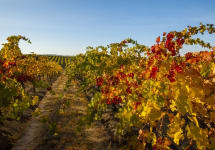Avennia Gravura 2016
-
Jeb
Dunnuck -
James
Suckling -
Wine
Enthusiast -
Wine
Spectator -
Robert
Parker



Product Details
Your Rating
Somm Note
Winemaker Notes
#80 Wine Enthusiast Top 100 Wines of 2019
The 2016 boasts classic Gravura aromas of rich black cherry and plums, graphite, cedar, thyme, and dark milk chocolate. Palate is deep and structured with red and black fruits, crème de cassis, mountain flowers, and damp clay. Lifting acidity and fine-grained, pliant tannins make this wine ideal for food.
Blend: 48% Cabernet Sauvignon, 41% Merlot, 11% Cabernet Franc
Professional Ratings
-
Jeb Dunnuck
The 2016 Gravura checks in as 48% Cabernet Sauvignon, 41% Merlot, and the balance Cabernet Franc, aged 20 months in 60% new French oak. It's another rock star of a wine from Chris that sports a saturated purple color, complex notes of blackberries, black cherries, damp earth, and spring flowers, hints of subtle oak, medium body, and perfect balance. Drink this seamless blend over the coming 10-15 years.
-
James Suckling
Attractive rich dark berries with some blueberries of offer, as well as dark, bracken-like, savory influences. The palate has a smooth and succulent edge that really holds a lot of flavor in effortless style. Approachable yet age-worthy red. Drink or hold.
-
Wine Enthusiast
A blend of 48% Cabernet Sauvignon and 41% Merlot make up the majority of this wine, with the balance Cabernet Franc. With fruit coming from a who's who of vineyards, the aromas draw you into the glass, with notes of dried herb, flower, thyme, cherry and graphite, showing a sense of delineation and detail that heightens the appeal. Exquisitely balanced fruit flavors follow. Bittersweet chocolate notes linger on the long finish. It brings a sense of gracefulness but has enough structure to reward some time in the cellar.
Editors' Choice -
Wine Spectator
Vibrant and well-knit, with expressive cherry, toasted spice and smoked herb flavors that take on structure toward the broad-shouldered tannins. Cabernet Sauvignon, Merlot and Cabernet Franc. Drink now through 2025.
-
Robert Parker's Wine Advocate
A blend of 40% Cabernet Sauvignon, 41% Merlot and 11% Cabernet Franc, the 2016 Gravura opens to a mineral-laced core of dark fruits on the nose, followed by blackberry, dusty plum and cassis, with hints of sage and black tea wafting from the glass. Medium to full-bodied, the wine gives flavors of graphite and soft, sweet herbs on the palate. The finish is elegant, long and lingering, revealing a wine that will last for years to come. Only 350 cases were produced.
Other Vintages
2020-
Robert
Parker -
Jeb
Dunnuck -
James
Suckling
-
Wine
Enthusiast -
James
Suckling -
Jeb
Dunnuck -
Wine
Spectator -
Robert
Parker
-
Jeb
Dunnuck -
Robert
Parker -
James
Suckling -
Wine
Enthusiast
-
Robert
Parker -
Jeb
Dunnuck
-
Wine
Enthusiast -
Robert
Parker
-
Wine
Enthusiast -
Robert
Parker -
Wine
Spectator





Avennia is inspired by the Roman name for the city of Avignon, and signifies for us the heart of Old World winemaking. The wines are designed to tease rather than flaunt; pique interest, not beg for attention. They stand for elegance, delicacy, purity. The wines are made to enhance conversation, not dominate it, and will be a welcome guest at the table.

One of the world’s most classic and popular styles of red wine, Bordeaux-inspired blends have spread from their homeland in France to nearly every corner of the New World. Typically based on either Cabernet Sauvignon or Merlot and supported by Cabernet Franc, Malbec and Petit Verdot, the best of these are densely hued, fragrant, full of fruit and boast a structure that begs for cellar time. Somm Secret—Blends from Bordeaux are generally earthier compared to those from the New World, which tend to be fruit-dominant.

A large and geographically diverse AVA capable of producing a wide variety of wine styles, the Columbia Valley AVA is home to 99% of Washington state’s total vineyard area. A small section of the AVA even extends into northern Oregon!
Because of its size, it is necessarily divided into several distinctive sub-AVAs, including Walla Walla Valley and Yakima Valley—which are both further split into smaller, noteworthy appellations. A region this size will of course have varied microclimates, but on the whole it experiences extreme winters and long, hot, dry summers. Frost is a common risk during winter and spring. The towering Cascade mountain range creates a rain shadow, keeping the valley relatively rain-free throughout the entire year, necessitating irrigation from the Columbia River. The lack of humidity combined with sandy soils allows for vines to be grown on their own rootstock, as phylloxera is not a serious concern.
Red wines make up the majority of production in the Columbia Valley. Cabernet Sauvignon is the dominant variety here, where it produces wines with a pleasant balance of dark fruit and herbs. Wines made from Merlot are typically supple, with sweet red fruit and sometimes a hint of chocolate or mint. Syrah tends to be savory and Old-World-leaning, with a wide range of possible fruit flavors and plenty of spice. The most planted white varieties are Chardonnay and Riesling. These range in style from citrus and green apple dominant in cooler sites, to riper, fleshier wines with stone fruit flavors coming from the warmer vineyards.
